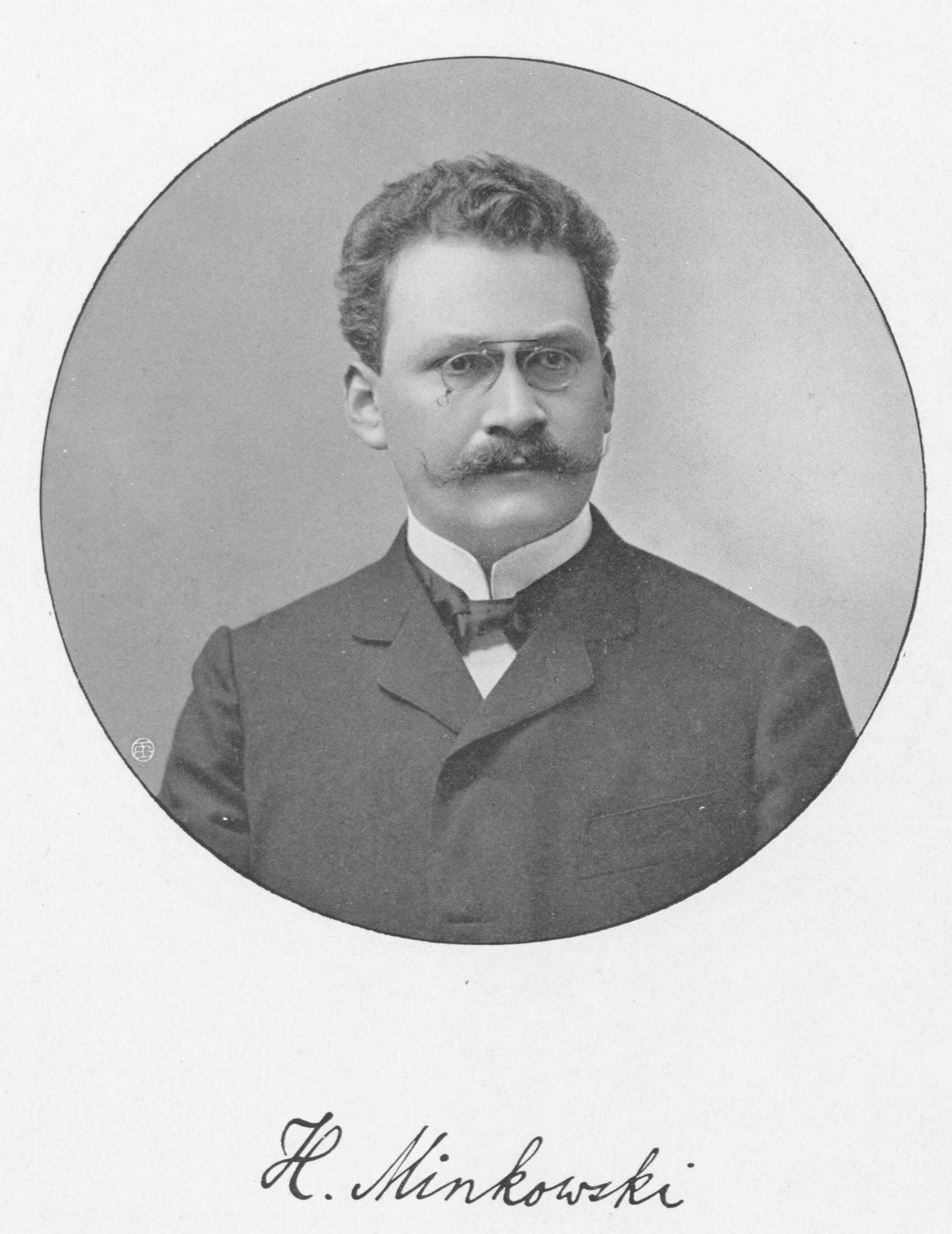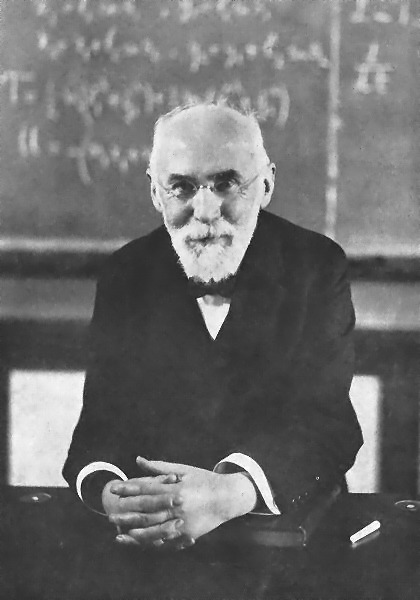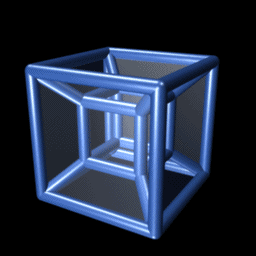|
Minkowski Spacetime
In physics, Minkowski space (or Minkowski spacetime) () is the main mathematical description of spacetime in the absence of gravitation. It combines inertial space and time manifolds into a four-dimensional model. The model helps show how a spacetime interval between any two events is independent of the inertial frame of reference in which they are recorded. Mathematician Hermann Minkowski developed it from the work of Hendrik Lorentz, Henri Poincaré, and others said it "was grown on experimental physical grounds". Minkowski space is closely associated with Einstein's theories of special relativity and general relativity and is the most common mathematical structure by which special relativity is formalized. While the individual components in Euclidean space and time might differ due to length contraction and time dilation, in Minkowski spacetime, all frames of reference will agree on the total interval in spacetime between events.This makes spacetime distance an invarian ... [...More Info...] [...Related Items...] OR: [Wikipedia] [Google] [Baidu] |
Special Relativity
In physics, the special theory of relativity, or special relativity for short, is a scientific theory of the relationship between Spacetime, space and time. In Albert Einstein's 1905 paper, Annus Mirabilis papers#Special relativity, "On the Electrodynamics of Moving Bodies", the theory is presented as being based on just Postulates of special relativity, two postulates: # The laws of physics are Invariant (physics), invariant (identical) in all Inertial frame of reference, inertial frames of reference (that is, Frame of reference, frames of reference with no acceleration). This is known as the principle of relativity. # The speed of light in vacuum is the same for all observers, regardless of the motion of light source or observer. This is known as the principle of light constancy, or the principle of light speed invariance. The first postulate was first formulated by Galileo Galilei (see ''Galilean invariance''). Background Special relativity builds upon important physics ide ... [...More Info...] [...Related Items...] OR: [Wikipedia] [Google] [Baidu] |
Lorentz Boost
In physics, the Lorentz transformations are a six-parameter family of linear transformations from a coordinate frame in spacetime to another frame that moves at a constant velocity relative to the former. The respective inverse transformation is then parameterized by the negative of this velocity. The transformations are named after the Dutch physicist Hendrik Lorentz. The most common form of the transformation, parametrized by the real constant v, representing a velocity confined to the -direction, is expressed as \begin t' &= \gamma \left( t - \frac \right) \\ x' &= \gamma \left( x - v t \right)\\ y' &= y \\ z' &= z \end where and are the coordinates of an event in two frames with the spatial origins coinciding at , where the primed frame is seen from the unprimed frame as moving with speed along the -axis, where is the speed of light, and \gamma = \frac is the Lorentz factor. When speed is much smaller than , the Lorentz factor is negligibly different from 1, but a ... [...More Info...] [...Related Items...] OR: [Wikipedia] [Google] [Baidu] |
Translation (geometry)
In Euclidean geometry, a translation is a geometric transformation that moves every point of a figure, shape or space by the same Distance geometry, distance in a given direction (geometry), direction. A translation can also be interpreted as the addition of a constant vector space, vector to every point, or as shifting the Origin (mathematics), origin of the coordinate system. In a Euclidean space, any translation is an isometry. As a function If \mathbf is a fixed vector, known as the ''translation vector'', and \mathbf is the initial position of some object, then the translation function T_ will work as T_(\mathbf)=\mathbf+\mathbf. If T is a translation, then the image (mathematics), image of a subset A under the function (mathematics), function T is the translate of A by T . The translate of A by T_ is often written as A+\mathbf . Application in classical physics In classical physics, translational motion is movement that changes the Position (geometry), positio ... [...More Info...] [...Related Items...] OR: [Wikipedia] [Google] [Baidu] |
Reflection (mathematics)
In mathematics, a reflection (also spelled reflexion) is a mapping from a Euclidean space to itself that is an isometry with a hyperplane as the set of fixed points; this set is called the axis (in dimension 2) or plane (in dimension 3) of reflection. The image of a figure by a reflection is its mirror image in the axis or plane of reflection. For example the mirror image of the small Latin letter p for a reflection with respect to a vertical axis (a ''vertical reflection'') would look like q. Its image by reflection in a horizontal axis (a ''horizontal reflection'') would look like b. A reflection is an involution: when applied twice in succession, every point returns to its original location, and every geometrical object is restored to its original state. The term ''reflection'' is sometimes used for a larger class of mappings from a Euclidean space to itself, namely the non-identity isometries that are involutions. The set of fixed points (the "mirror") of such an isome ... [...More Info...] [...Related Items...] OR: [Wikipedia] [Google] [Baidu] |
Rotation Matrix
In linear algebra, a rotation matrix is a transformation matrix that is used to perform a rotation (mathematics), rotation in Euclidean space. For example, using the convention below, the matrix :R = \begin \cos \theta & -\sin \theta \\ \sin \theta & \cos \theta \end rotates points in the plane counterclockwise through an angle about the origin of a two-dimensional Cartesian coordinate system. To perform the rotation on a plane point with standard coordinates , it should be written as a column vector, and matrix multiplication, multiplied by the matrix : : R\mathbf = \begin \cos \theta & -\sin \theta \\ \sin \theta & \cos \theta \end \begin x \\ y \end = \begin x\cos\theta-y\sin\theta \\ x\sin\theta+y\cos\theta \end. If and are the coordinates of the endpoint of a vector with the length ''r'' and the angle \phi with respect to the -axis, so that x = r \cos \phi and y = r \sin \phi, then the above equations become the List of trigonometric identities#Angle sum and ... [...More Info...] [...Related Items...] OR: [Wikipedia] [Google] [Baidu] |
Euclidean Group
In mathematics, a Euclidean group is the group of (Euclidean) isometries of a Euclidean space \mathbb^n; that is, the transformations of that space that preserve the Euclidean distance between any two points (also called Euclidean transformations). The group depends only on the dimension ''n'' of the space, and is commonly denoted E(''n'') or ISO(''n''), for ''inhomogeneous special orthogonal'' group. The Euclidean group E(''n'') comprises all translations, rotations, and reflections of \mathbb^n; and arbitrary finite combinations of them. The Euclidean group can be seen as the symmetry group of the space itself, and contains the group of symmetries of any figure (subset) of that space. A Euclidean isometry can be ''direct'' or ''indirect'', depending on whether it preserves the handedness of figures. The direct Euclidean isometries form a subgroup, the special Euclidean group, often denoted SE(''n'') and E+(''n''), whose elements are called rigid motions or Euclidean ... [...More Info...] [...Related Items...] OR: [Wikipedia] [Google] [Baidu] |
Euclidean Distance
In mathematics, the Euclidean distance between two points in Euclidean space is the length of the line segment between them. It can be calculated from the Cartesian coordinates of the points using the Pythagorean theorem, and therefore is occasionally called the Pythagorean distance. These names come from the ancient Greek mathematicians Euclid and Pythagoras. In the Greek deductive geometry exemplified by Euclid's ''Elements'', distances were not represented as numbers but line segments of the same length, which were considered "equal". The notion of distance is inherent in the compass tool used to draw a circle, whose points all have the same distance from a common center point. The connection from the Pythagorean theorem to distance calculation was not made until the 18th century. The distance between two objects that are not points is usually defined to be the smallest distance among pairs of points from the two objects. Formulas are known for computing distances b ... [...More Info...] [...Related Items...] OR: [Wikipedia] [Google] [Baidu] |
Isometry Group
In mathematics, the isometry group of a metric space is the set of all bijective isometries (that is, bijective, distance-preserving maps) from the metric space onto itself, with the function composition as group operation. Its identity element is the identity function. The elements of the isometry group are sometimes called motions of the space. Every isometry group of a metric space is a subgroup of isometries. It represents in most cases a possible set of symmetries of objects/figures in the space, or functions defined on the space. See symmetry group. A discrete isometry group is an isometry group such that for every point of the space the set of images of the point under the isometries is a discrete set. In pseudo-Euclidean space the metric is replaced with an isotropic quadratic form; transformations preserving this form are sometimes called "isometries", and the collection of them is then said to form an isometry group of the pseudo-Euclidean space. Examples * The is ... [...More Info...] [...Related Items...] OR: [Wikipedia] [Google] [Baidu] |
Euclidean Space
Euclidean space is the fundamental space of geometry, intended to represent physical space. Originally, in Euclid's ''Elements'', it was the three-dimensional space of Euclidean geometry, but in modern mathematics there are ''Euclidean spaces'' of any positive integer dimension ''n'', which are called Euclidean ''n''-spaces when one wants to specify their dimension. For ''n'' equal to one or two, they are commonly called respectively Euclidean lines and Euclidean planes. The qualifier "Euclidean" is used to distinguish Euclidean spaces from other spaces that were later considered in physics and modern mathematics. Ancient Greek geometers introduced Euclidean space for modeling the physical space. Their work was collected by the ancient Greek mathematician Euclid in his ''Elements'', with the great innovation of '' proving'' all properties of the space as theorems, by starting from a few fundamental properties, called '' postulates'', which either were considered as evid ... [...More Info...] [...Related Items...] OR: [Wikipedia] [Google] [Baidu] |
Four-dimensional Space
Four-dimensional space (4D) is the mathematical extension of the concept of three-dimensional space (3D). Three-dimensional space is the simplest possible abstraction of the observation that one needs only three numbers, called ''dimensions'', to describe the sizes or locations of objects in the everyday world. This concept of ordinary space is called Euclidean space because it corresponds to EuclidEuclidean geometry, 's geometry, which was originally abstracted from the spatial experiences of everyday life. Single locations in Euclidean 4D space can be given as Vector space, vectors or ''n-tuples, 4-tuples'', i.e., as ordered lists of numbers such as . For example, the volume of a rectangular box is found by measuring and multiplying its length, width, and height (often labeled , , and ). It is only when such locations are linked together into more complicated shapes that the full richness and geometric complexity of 4D spaces emerge. A hint of that complexity can be seen in ... [...More Info...] [...Related Items...] OR: [Wikipedia] [Google] [Baidu] |
Invariant (physics)
In theoretical physics, an invariant is an observable of a physical system which remains unchanged under some transformation. Invariance, as a broader term, also applies to the no change of form of physical laws under a transformation, and is closer in scope to the mathematical definition. Invariants of a system are deeply tied to the symmetries imposed by its environment. Invariance is an important concept in modern theoretical physics, and many theories are expressed in terms of their symmetries and invariants. Examples In classical and quantum mechanics, invariance of space under translation results in momentum being an invariant and the conservation of momentum, whereas invariance of the origin of time, i.e. translation in time, results in energy being an invariant and the conservation of energy. In general, by Noether's theorem, any invariance of a physical system under a continuous symmetry leads to a fundamental conservation law. In crystals, the electron density is ... [...More Info...] [...Related Items...] OR: [Wikipedia] [Google] [Baidu] |





